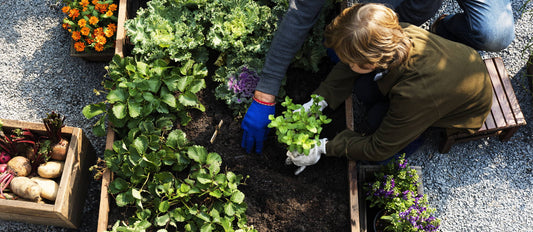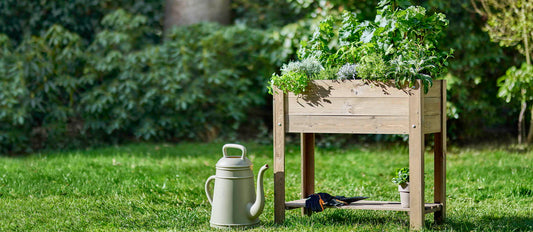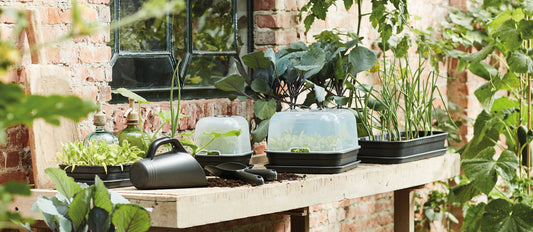Urban gardening is increasingly becoming the norm. More and more people want to know where their food comes from and are for that reason starting to grow it themselves. If you don't have a big garden, vegetable gardening may seem like it could be difficult, but there are always solutions for getting some earth under your fingernails. With the following tips you can easily create your own urban garden.
Gardening on the balcony or (rooftop) patio
You really don't need a large garden to grow your own fruit and vegetables, because most varieties also grow well in pots, crates or even balcony containers. In fact, a patio or balcony is ideal for growing fruit and vegetables, because the soil warms up faster, so that the seeds and plants grow more quickly. Another advantage is that fruit and vegetables in pots are much less vulnerable to pests. Let's get started!
-
Choose the right pot
You can plant fruit and vegetables in a pot or grow them yourself by sowing them in a pot. Place fruit and vegetables that can grow very large, such as tomatoes, in a flower pot 50 centimetres high and 50 centimetres in diameter. Small varieties will fit in pots measuring 25 by 25 centimetres. Remember that the smaller the pot, the more often you need to water the plant. The pot heats up faster, causing the soil to dry out faster. It is also important that the pot is equipped with holes in the bottom to drain the excess water. This prevents the plants from getting mouldy. Do you have more space on the balcony or (rooftop) patio? Then opt for a crate or a vegetable garden container In them, you can grow a larger variety of fruit and vegetables, and will really get the feeling of having a wonderfully healthy vegetable garden.
-
Soil
In addition to the right pot, potting soil is most important for a good harvest. A proper base of potting soil is essential for keeping your fruit and vegetable plants happy. You can grown many varieties in special vegetable garden potting soil. Always fill the pot or vegetable garden container with fresh potting soil so that the plants and seeds can get enough nutrition from the soil. Some species prefer a different soil or need certain substances for optimal growth. You can always find this on the plant label on the packaging. For a number of vegetables, it is also important that the soil gets additional fertiliser once or twice during the growing season.
-
Pre-sowing
Most seeds cannot be planted directly outside. In the winter months you can already make a start with the indoor pre-sowing of many vegetable, fruit and herb seeds. In February, you can start sowing strawberry, cucumber, pepper, lettuce, tomato and many other seeds. You can grow these seeds in special vegetable garden containers. In the spring, you can re-pot the plants in the large vegetable garden container outside.
-
All vitamins from yout own harvest
Now everything is ready to get started with plants. All you have to do is choose the seeds for the garden. Take good account of the space you have, in a vegetable garden container you can grow different fruit and vegetables than in pots. Tomatoes, strawberries, beans, carrots, snow peas and radishes are ideal for pots. Blackberries, for example, are less suitable for the balcony, as they want space to climb. In addition to a vegetable garden on the balcony, consider small fruit trees. For example, tangerine and lemon trees can also grow perfectly on a balcony or (rooftop) patio with a lot of sunlight. Delicious for making smoothies in the summer!
Your own indoor garden
In addition to urban gardening, indoor gardening is also on the rise. Join this trend now by starting your own herb garden on the kitchen counter. With Bakker's Bags to Nature you can easily grow the tastiest herbs at home, which you can later use to make delicious dishes. It's so simple that even those with the palest of green-tinted fingers can expect a fantastic harvest. You grow these herbs as follows:
- Step 1: Open the recyclable bag with soil in it and add the plant food.
- Step 2: Mix the soil with about 400 ml of water.
- Step 3: Shake the soil well, so that the water is well absorbed.
- Step 4: Scatter the seeds over the soil and press them in lightly so that there is good contact with the soil.
- Step 5: Place the bag in a light spot, not in direct sun.
After about a week, the first herbs should be ready to harvest. Super easy and super tasty!
Do you want to get started with your own urban garden or indoor garden? Then view Bakker's wide range of fruit and vegetables to see all plants, seeds and other vegetable garden products.




